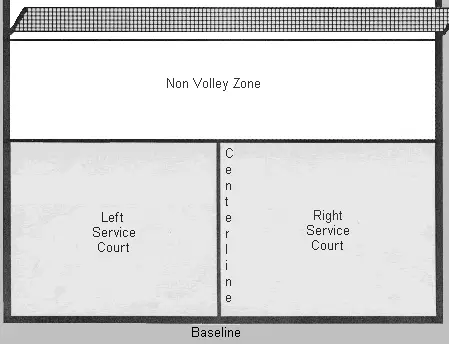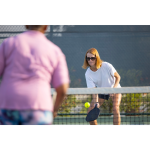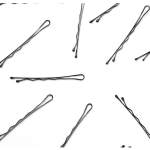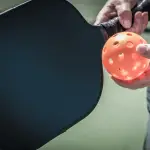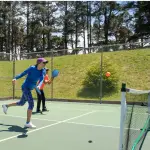One of the first things you learn in Pickleball is to stay out of the kitchen. What’s the kitchen? It is a term for the non-volley zone in Pickleball or an area seven feet from the net running the width of the court. This means you cannot hit the ball in the air if you are standing between the net and the kitchen line. However, you can enter the non-volley zone in Pickleball if the ball bounces in this area. While I’m going to go over the rules in detail for the non-volley zone later in this post, I’m first going to talk about where you should stand and why.
Toe the Line
Sarah Ansboury, a professional Pickleball player, talks about toeing the line in Pickleball. This means players should stand within one inch of the non-volley zone in Pickleball. How many players actually do this? I spent some time watching the feet of other players while I was waiting for a match. Most players did not stand this close even when one player could start at the kitchen line since the team was returning serve. Players were generally 3-12″ from the line in this situation.
What’s the advantage of toeing the line? Controlling the net means controlling the point as it gives you a better chance to win the rally. When you are close to the kitchen line you have both a better angle to hit at your opponents feet and a better chance to return shots from your opponent. You will see better players stand an inch from the non-volley zone in Pickleball and lean in to contact the ball early. This allows them to contact the ball at a higher point and it gives the opponent less time to react to the ball.
Why Players Don’t Toe the Line
So, why don’t players toe the line? Some are afraid of the ball being hit hard at them because they are close to the net. Others move back when they see their opponent is going to hit an overhead. Some are concerned about covering their opponent’s lob. The latter case is where I see most people getting into trouble as they like to stand a foot from the kitchen line to be able to cover the lob better.
So what do you do if you are afraid of getting lobbed? Don’t back up from the kitchen line! First, consider your opponent. Have they hit a lob to you before? If so, was it effective? Can they hit this shot consistently? If your opponent hits few lobs and/or isn’t consistent, be sure to toe the line.
Even if your opponent hits a consistently good lob, should you cheat back from the kitchen line? You need to assess your strengths as a player. Are you tall? If so, why are you moving back? You should be able to reach up high to cover lob shots. Are you quick around the court or do you anticpate well? I’m not tall but I can move pretty well so I don’t worry about the lob. Instead I chase it down and usually hit a drop shop from deep in the court. Like Sarah Ansboury, I really believe in toeing the line and being as close as possible to the non-volley zone in Pickleball.
Get to the Kitchen Line Quickly
When my team is serving, I like to hustle up to the kitchen line immediately after we hit our third shot. This is something I’ve talked about in a number of posts before on how to win and improve your game. By hitting a third shot drop, I have a better chance of getting all of the way to the line because the speed of the ball is less than if I hit a drive. I still mix in a hard shot to keep my opponents off balance but I may not quite make it to the kitchen line. If this happens, I stop before hitting the ball and then I move all the way up to the line after making the shot.
When I hit a drop shot that bounces too high or a drive too high over the net, I can get stuck deep in the court if the other team makes an offensive play. If this happens, go ahead and stay deep in the court near the baseline. Then hit a fifth shot drop or seventh shot drop if needed.
Stay Out of the Kitchen and No Man’s Land
The goal is to not get stuck in no man’s land. This is a concept from World War I where soldiers were at great risk in the area between the trenches. In tennis, no man’s land is the area one yard behind the service line to one yard in front of the baseline. While I don’t think we have a definition for no man’s land in Pickleball, it’s basically the area where you are too deep to hit a volley but too close to the net to hit a ground stroke. This means your opponent can easily hit at your feet so you are likely to lose the point.
The same thing holds true when you are returning serve. You want to get to the kitchen line quickly. The best way to do this is to return the ball deep in the court. This way you have enough time to toe the line. If your opponent hits a deep serve to you, it can take some time to move up. I compensate for my opponent’s deep serve by hitting a deep ball back that is higher than normal. Then I have enough time to move all of the way to the kitchen line.
Rules for the Non-Volley Zone in Pickleball
The official tournament rule book for Pickleball has nine different rules related to the non volley zone. Since you can read about them here, I’m just going to cover the parts of the rule least understood by players.
The rules clearly state that neither a player or anything in contact with the player can touch the non-volley zone in Pickleball. This means if I hit a volley outside of the non volley zone but drop my paddle in the kitchen, it is a fault. If I’m wearing sunglasses and hit a volley outside of the kitchen but the glasses drop into the non volley zone, it is also a fault.
9.B. A fault will be declared if, in the act of volleying the ball,
a player or anything contacting the player touches the
non-volley zone.
9.B.1. The act of volleying the ball includes the swing,
the follow-through, and the momentum from the
action.
9.B.2. If the paddle touches the non-volley zone during
the volley motion, before or after contacting the
ball, it is a fault.
More Rules
I was playing a few weeks ago with a player fairly new to the game and he hit a volley outside of the kitchen but then fell into the non volley zone. This is also considered a fault in Pickleball even if the ball is considered dead before the person entered the non volley zone.
9. C. It is a fault if the player’s momentum causes the player
to contact anything that is touching the non-volley zone,
including the player’s partner.
9.C.1. It is a fault even if the ball is declared dead
before the player contacts the non-volley zone.
As I mentioned earlier, you can enter the kitchen if you are not hitting a volley. If you go into the non-volley zone in Pickleball to hit a ball that bounced, you must establish position outside of kitchen before you hit a volley.
9. D. If a player has touched the non-volley zone for any
reason, that player cannot volley a return until both feet
have made contact with the playing surface completely
outside the non-volley zone. A maneuver such as
standing within the non-volley zone, jumping up to hit a
volley, and then landing outside the non-volley zone is
prohibited.
Summary
At this point, you may be wondering why Pickleball even has a non volley zone. According to a history of the game, one of the co-founders was well over six feet. To prevent him from smashing the ball at his opponents, the kitchen was created. The great thing about this rule is that it is an equalizer so players who are taller don’t have an advantage created from their height. So when playing Pickleball, make sure you move quickly to “toe the line” and stay out of the kitchen when hitting a volley.

